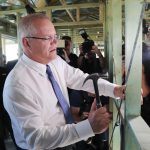The impact of population ageing and immigration on the Australian housing market

Australia has an accelerating ageing population, but fortunately we have strong inflows of young and skilled migrants. George Kudrna explains what this means for house prices.
The recent NSW intergenerational report projects that as a result of an ageing population, the fiscal gap between state revenues and expenditures will widen to 3.4% of Gross State Product by 2056.[1]
This projection relies to some extent on the assumed growth of house prices and their positive effect on state revenues. In this article, I discuss the likely impacts of population ageing on housing demand and house prices, building on the discussion of the literature on this topic provided by Kudrna (2016).[2]
Australia has an accelerating ageing population, with the size of the population aged 65+ (80+) projected to increase 130% (233%) to 8.2 million (3.1 million) by 2050.[3] Accordingly, the effects of population ageing on the housing market fall into two distinct phases. In the short to medium term (over the next 20 years), the effect is likely to be positive as the median age of the population increases – arcing towards an age when housing is in highest demand (around 45 years). Thereafter, as the elderly begins to downsize and spend their housing wealth (increasing housing supply), and a relatively smaller working-age cohort is generating demand, a decline in house prices should ensue.
Moreover, the fast-growing elderly population will generate an enormous intergenerational transfer of predominantly housing wealth. The consequence of this will be further reduced demand for housing from their already middle-aged children.
The finding by Guest and Swift (2010) indicates that as a result of changing demographics, average Australian house prices may be between 3% to 27% lower than they otherwise would be over the period of 2008-2050.[4] Note, however, that their projection does not account for the negative impact of the aforementioned intergenerational transfer of housing wealth on demand for housing and prices. There is also significant uncertainty about the housing and pension policy rules, and it is likely that they will not remain unchanged, given the growing fiscal pressure on the government.
Although demographic transition in Australia is projected to result in the future population being older, fortunately, the population will also be significantly larger due mainly to strong inflows of young and skilled migrants. This strong immigration (with estimates for net overseas migration (NOM) ranging from 120,000 to 240,000 persons per year[5]) will be the positive for future housing demand and prices, especially benefiting the cities of Sydney and Melbourne with strong employment. For the sake of the overall economy, it is important that the positive effects of immigration dominate in the long run in order for house prices to remain strong.
The quantitative analysis of the implications of future demographic changes on the Australian housing market and the overall economy is part of my ongoing research. The research project aims to develop an Australian economic model incorporating housing decisions and intergenerational wealth transfers to quantify the effects of population ageing and immigration on housing demand and house prices.
- [1] NSW Government (2016), Future State NSW 2056, NSW Intergenerational Report.
- [2] Kudrna, G. (2016), “Population ageing and housing: Policy implications”, CEPAR working paper 2016/13.
- [3] These figures are based on the medium demographic projection by Productivity Commission (2013), “An ageing Australia: Preparing for the future”, Research report, Canberra.
- [4] Guest, R. and R. Swift (2010), “Population ageing and house prices in Australia”, Australian Economic Review 43, 240-253.
- [5] Based on the low and high NOM assumptions by Productivity Commission (2013).
George Kudrna is a Research Fellow at the ARC Centre of Excellence in Population Ageing Research (CEPAR), located at UNSW. He received a PhD in Economics from the University of Sydney in 2009. His research encompasses the areas of pension economics, population ageing and macroeconomics. He develops and applies rigorous macroeconomic models to investigate the economy-wide impacts of demographic change and pension reforms in Australia. George has published in both national and international economic journals, including the Economic Record, the Journal of Macroeconomics and Macroeconomic Dynamics. He has also co-authored several government reports, including commissioned reports for the Australian Treasury and for the U.S. Social Security Administration. His ongoing projects at CEPAR include research on taxation of superannuation, means testing of the age pension and role of housing in an ageing society.











